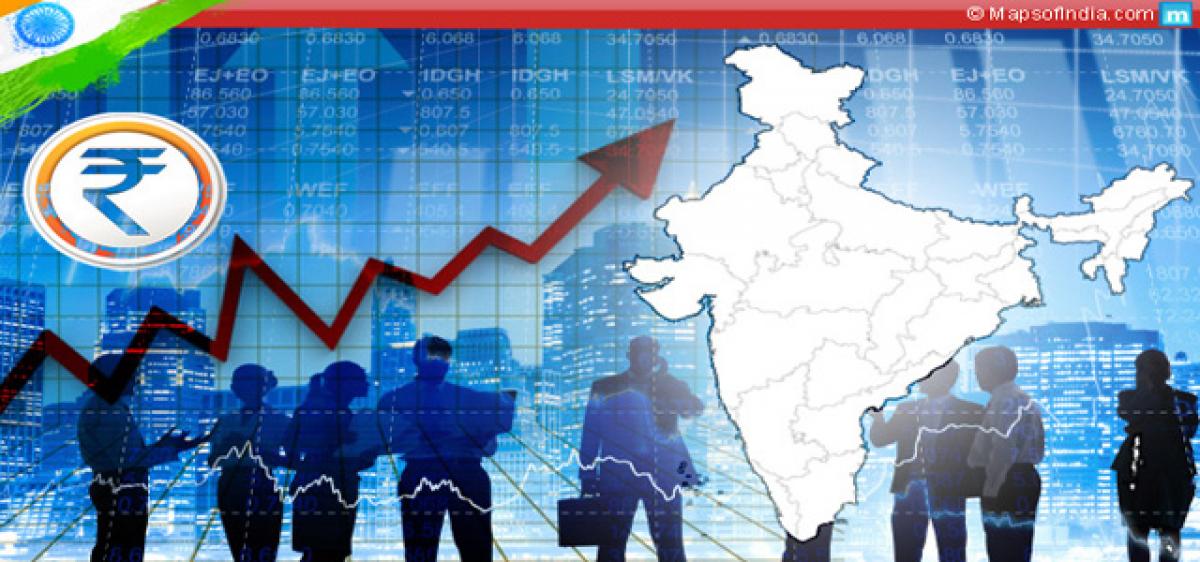Live
- NFR issues notice to 20 GCPA leaders for disrupting railway services
- Bengal school job case: CBI submits third supplementary charge sheet
- Opelka beats Mpetshi Perricard in Brisbane, reaches first final since 2022
- RJD to convene national executive meet in Patna on Jan 18
- ‘Temple’ shirt row continues in Kerala
- Rajnath Singh to present 'chadar' at Ajmer Sharif Dargah on Jan 5
- No Entry to Collectorate Without a Helmet - Collector Badavath Santosh
- Every Pregnant Woman Deserves Safe Motherhood -DMHO Dr. K.V. Swarajyalakshmi
- Human Metapneumovirus (HMPV) Surge in China: Is It Similar to Covid-19?
- Bengaluru Gears Up for Anniversary Show of Classic Motorcycles
Just In

The Indian Economy has sustained a macro-economic environment of relatively lower inflation, fiscal discipline and moderate current account deficit coupled with broadly stable rupee-dollar exchange rate. The Economic Survey 2016-17 states
The Indian Economy has sustained a macro-economic environment of relatively lower inflation, fiscal discipline and moderate current account deficit coupled with broadly stable rupee-dollar exchange rate. The Economic Survey 2016-17 states that such sustenance is despite continuing global sluggishness. It says:
Fiscal
ndirect taxes grew by 26.9 per cent during April-November 2016.
The strong growth in revenue expenditure during April-November 2016 was boosted mainly by a 23.2 per cent increase in salaries due to the implementation of the Seventh Pay Commission and a 39.5 per cent increase in the grants for creation of capital assets.
Prices
The headline inflation as measured by Consumer Price Index (CPI) remained under control for the third successive financial year. The average CPI inflation declined to 4.9 per cent in 2015-16 from 5.9 per cent in 2014-15 and stood at 4.8 per cent during April-December 2015.
Inflation based on Wholesale Price Index (WPI) declined to (-) 2.5 per cent in 2015-16 from 2.0 per cent in 2014-15 and averaged 2.9 per cent during April-December 2016.
Inflation is repeatedly being driven by narrow group of food items, of these pulses continued to be the major contributor of food inflation.
The CPI based core inflation has remained sticky in the current fiscal year averaging around 5 per cent.
Trade
The trend of negative export growth was reversed somewhat during 2016-17 (April-December), with exports growing at 0.7 per cent to US$ 198.8 billion. During 2016-17 (April-December) imports declined by 7.4 per cent to US$ 275.4 billion.
Trade deficit declined to US$ 76.5 billion in 2016-17 (April-December) as compared to US$ 100.1 billion in the corresponding period of the previous year.
The current account deficit (CAD) narrowed in the first half (H1) of 2016-17 to 0.3 per cent of GDP from 1.5 per cent in H1 of 2015-16 and 1.1 per cent in 2015-16 full year.
Robust inflows of foreign direct investment and net positive inflow of foreign portfolio investment were sufficient to finance CAD leading to an accretion in foreign exchange reserves in H1 of 2016-17.
In H1 of 2016-17, India’s foreign exchange reserves increased by US$ 15.5 billion on BoP basis.
During 2016-17 so far, the rupee has performed better than most of the other emerging market economies.
External Debt
At end-September 2016, India’s external debt stock stood at US$ 484.3 billion, recording a decline of US$ 0.8 billion over the level at end-March 2016.
Most of the key external debt indicators showed an improvement in September 2016 vis-à-vis March 2016. The share of short-term debt in total external debt declined to 16.8 per cent at end-September 2016 and foreign exchange reserves provided a cover of 76.8 per cent to the total external debt stock.
India’s key debt indicators compare well with other indebted developing countries and India continues to be among the less vulnerable countries.
Services
Service sector is estimated to grow at 8.9 per cent in 2016-17, almost the same as in 2015-16. It is the significant pick-up in public administration, defence and other services, boosted by the payouts of the Seventh Pay Commission that is estimated to push up the growth in services.
Social Infrastructure,
Employment and Human Development
The Parliament has passed the “Rights of Persons with Disabilities Act, 2016”. The Act aims at securing and enhancing the rights and entitlements of Persons with Disabilities.
The Act has proposed to increase the reservation in vacancies in government
establishments from 3 per cent to 4 per cent for those persons with benchmark disability and high support needs.

© 2024 Hyderabad Media House Limited/The Hans India. All rights reserved. Powered by hocalwire.com







